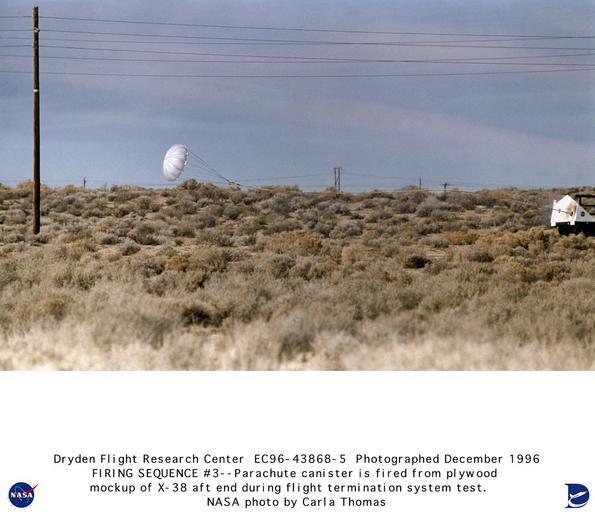MAKE A MEME
View Large Image

| View Original: | X-38,_Parachute_Canister_Fired_from_Plywood_Mockup_during_Flight_Termination_System_Test_DVIDS700816.jpg (1536x1321) | |||
| Download: | Original | Medium | Small | Thumb |
| Courtesy of: | commons.wikimedia.org | More Like This | ||
| Keywords: X-38, Parachute Canister Fired from Plywood Mockup during Flight Termination System Test DVIDS700816.jpg en The canister containing a seven-foot-diameter X-38 Flight Termination System FTS parachute is launched safely away from a plywood mockup of the X-38 by a pyrotechnic firing system on December 19 1996 at NASA Dryden Flight Research Center Edwards California The test was economically accomplished by mounting the mockup of the X-38's aft end minus vertical stabilizers on a truck prior to installation in the X-38 The X-38 Crew Return Vehicle CRV research project is designed to develop the technology for a prototype emergency crew return vehicle or lifeboat for the International Space Station The project is also intended to develop a crew return vehicle design that could be modified for other uses such as a joint U S and international human spacecraft that could be launched on the French Ariane-5 Booster The X-38 project is using available technology and off-the-shelf equipment to significantly decrease development costs Original estimates to develop a capsule-type crew return vehicle were estimated at more than 2 billion X-38 project officials have estimated that development costs for the X-38 concept will be approximately one quarter of the original estimate Off-the-shelf technology is not necessarily old technology Many of the technologies being used in the X-38 project have never before been applied to a human-flight spacecraft For example the X-38 flight computer is commercial equipment currently used in aircraft and the flight software operating system is a commercial system already in use in many aerospace applications The video equipment for the X-38 is existing equipment some of which has already flown on the space shuttle for previous NASA experiments The X-38's primary navigational equipment the Inertial Navigation System/Global Positioning System is a unit already in use on Navy fighters The X-38 electromechanical actuators come from previous joint NASA U S Air Force and U S Navy research and development projects Finally an existing special coating developed by NASA will be used on the X-38 thermal tiles to make them more durable than those used on the space shuttles The X-38 itself was an unpiloted lifting body designed at 80 percent of the size of a projected emergency crew return vehicle for the International Space Station although two later versions were planned at 100 percent of the CRV size The X-38 and the actual CRV are patterned after a lifting-body shape first employed in the Air Force-NASA X-24 lifting-body project in the early to mid-1970s The current vehicle design is base lined with life support supplies for about nine hours of orbital free flight from the space station It's landing will be fully automated with backup systems which allow the crew to control orientation in orbit select a deorbit site and steer the parafoil if necessary The X-38 vehicles designated V131 V132 and V-131R are 28 5 feet long 14 5 feet wide and weigh approximately 16 000 pounds on average The vehicles have a nitrogen-gas-operated attitude control system and a bank of batteries for internal power The actual CRV to be flown in space was expected to be 30 feet long The X-38 project is a joint effort between the Johnson Space Center Houston Texas JSC Langley Research Center Hampton Virginia LaRC and Dryden Flight Research Center Edwards California DFRC with the program office located at JSC A contract was awarded to Scaled Composites Inc Mojave California for construction of the X-38 test airframes The first vehicle was delivered to the JSC in September 1996 The vehicle was fitted with avionics computer systems and other hardware at Johnson A second vehicle was delivered to JSC in December 1996 Flight research with the X-38 at Dryden began with an unpiloted captive-carry flight in which the vehicle remained attached to its future launch vehicle Dryden's B-52 008 There were four captive flights in 1997 and three in 1998 plus the first drop test on March 12 1998 using the parachutes and parafoil Further captive and drop tests occurred in 1999 In March 2000 Vehicle 132 completed its third and final free flight in the highest fastest and longest X-38 flight to date It was released at an altitude of 39 000 feet and flew freely for 45 seconds reaching a speed of over 500 miles per hour before deploying its parachutes for a landing on Rogers Dry Lakebed In the drop tests the X-38 vehicles have been autonomous after airlaunch from the B-52 After they deploy the parafoil they have remained autonomous but there is also a manual mode with controls from the ground NASA Identifier NIX-EC96-43868-5 2009-09-23 Glenn Research Center https //www dvidshub net/image/700816 700816 2012-10-10 14 44 WASHINGTON DC US PD-USGov Langley Research Center Images from DoD uploaded by Fæ NASA X-38 | ||||